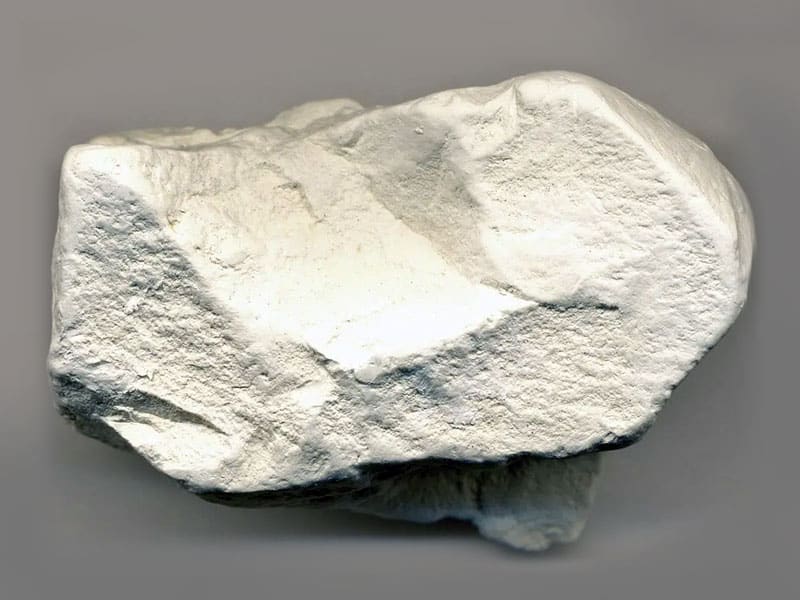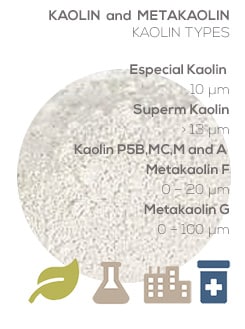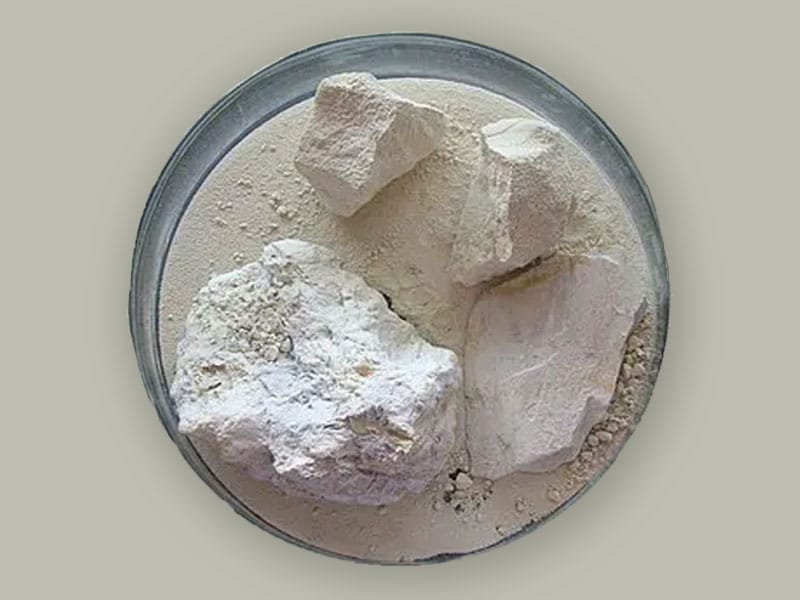Kaolin and Metakaolin

What is kaolin?
Kaolin is how rocks rich in the mineral kaolinite are known. Kaolinite is a hydrated aluminum silicate with the chemical formula Al2Si2O5(OH)4. It is a mineral made up of several thin hexagonal layers that are very easily exfoliated, that is, it is a rather fragile laminar mineral. Furthermore, it is a mineral with a triclinic crystalline system divided into two layers (tetrahedrons and octahedrons). It is a very soft mineral, with a hardness between 1 and 2 on the Mohs scale. It has a density of 2.6 g/cm³.
Metakaolin is a thermally activated aluminum silicate that is obtained by calcining kaolin at temperatures between 500 and 600ºC. When this calcination occurs, changes are produced in the crystalline structure of the mineral.

Kaolin. Available variants
SPECIAL and SUPREME KAOLIN
Materials with a very small granulometry and characteristic for their high levels of whiteness, of more than 92%. The Special Kaolin has a size of less than 10 microns, while the Supreme Kaolin is less than 13 µm.
KAOLIN P5B, MC, M and A
They are materials without such low granulometry or such high whiteness. Kaolin P5B is characterised by having a pH of 5, more acid than the other materials, and a whiteness level of 89%. Kaolin MC (85%) and Kaolin M (84%) are products with a good relationship between cost and whiteness. Kaolin A (80%) is used in applications where whiteness is not a priority.
METAKAOLIN F and G
They are materials produced by calcining and dehydrating kaolin. Due to their whiteness, they can be used in applications that require this property in the mineral or additive. Metakaolin F has a granulometry of 0 – 20 µm and Metakaolin G of 0 – 100 µm.
Kaolin and metakaolin are supplied in different particle sizes and degrees of whiteness, to satisfy the requirements and needs of the consumer.
What is kaolin used for?
Kaolin is a mineral with multiple applications in different sectors.
It is mainly used in the manufacture of paper, the elaboration of ceramics and concretes and the production of pigments, paints, varnishes and refractories. Kaolin is also used to fill plastic and rubber products.
In the agricultural and environmental sector, it is used to improve the soil, the manufacture of pesticides and fertilisers.
In cosmetics, it is known as white clay and is recognised for its excellent properties for purifying the skin and keeping teeth white.
Concrete and ceramics
Kaolin is a main ingredient in ceramic products. Kaolin is used in a wide range of products: porcelain, tiles, tableware, sanitary ware, electric porcelain, ceramics, and refractories.
Kaolinite is the most widely used mineral clay in ceramic applications due to its physical and chemical properties. Kaolin provides plasticity, green resistance, dry resistance, resistance to cooking, color, refractoriness, easy emptying in toilets, low or zero water absorption and control of shrinkage or contraction.
Methacolin is used in the manufacture of high-strength concrete. It is a highly white mineral, providing high added value to all kinds of products. Metakaolin is mainly used as a pozzolanic additive in mortars and concretes based on Portland or lime cement.
Paper
Kaolin is used in the paper industry to improve printing, whiteness and smoothness of sheets. Thanks to its rheology, brilliance, low viscosity, non-abrasiveness, particle size control, and flat, hexagonal plate-shaped surface, kaolin is used as a coating on the sheet surface making possible sharp photographic illustration and color printing. bright.
Paints and coatings
Kaolin is used as a pigment extender in paints: it modifies gloss, flow characteristics, handling and film properties. Primarily used in water-based interior latex paints. Kaolin is also used in industrial primers or oil-based exterior primers. It stands out for facilitating washability when using this clay and the retention of enamel.
Pigments and dyes
Kaolin is the main inorganic pigment used in inks. Kaolin improves ink retention and extends both the color and the white pigment. It is a good extender due to its low abrasion, easy dispersibility and low oil absorption, which minimize wear on the printing plate. To preserve the gloss on the ink film, the kaolin extender must be of a fine particle size, between 0.2 and 0.5 µm.
Rubber and gums
In rubber, kaolin is used as a pigment because of its whiteness and low cost. It is also used as a filler in natural or synthetic rubber products since it provides resistance, abrasion, rigidity and greater extrusion to the product.
Plastic compounds
Caolin is applied as a filler for plastics. Above all it is used in PVC, polyvinyl chloride, coatings on wires and cables. In fiberglass it is used as reinforcement.
Kaolin gives the plastic a smooth surface finish, reduces cracking and shrinkage, improves thermal stability and resistance to chemical attack and wear. It also contributes to high impact force and helps control flow properties. Generally, the smaller the kaolin particle size, the better the reinforcement of the physical properties of the polymer.
Cosmetics
Kaolin or white clay is widely used in cosmetics for its anti-inflammatory, antibacterial and exfoliating properties. It is used in masks, creams, toothpaste and deodorants, to soothe sensitive skin, absorption and regulation of sebum and perspiration and also as a dental whitener.
It can be used in cosmetics as an active ingredient or as a white dye (CI 77004). If it is used as an active ingredient, it must be declared on the Inci list as KAOLIN; as a colorant, it should be declared as CI 77004.
Soil improvement
Kaolin in agriculture is effective in reducing thermal stress, heat stroke, burns and damaging effects caused by high temperatures. It forms a white, reflective protective film that helps the crop withstand heat. It also increases the efficiency of water and improves the productive potential and yield of the soil.
Insecticides and pesticides
Kaolin is used as a repellent for certain pests such as leafhoppers, pear tree psylla, tryps, lepidoptera or diptera.
Supplies
Kaolin and metakaolin can be supplied in different particle sizes depending on the type of product desired: 0-10 µm, 0-13 µm, 0-20 µm and 0-100 µm. Products can also be supplied with different levels of whiteness depending on what they want to be used for: > 92%, > 89%, > 85%, > 84% and > 80%.
For the different applications, one size or another is recommended and a more or less high whiteness level.
It can be supplied in 25 kg bags (on 1,000 kg pallets) or 1,000 kg big bags.

To request a budget about kaolin, please contact us.
Offfice
Casp, 116, Ppal, 4ª 08013 BARCELONA – Spain
